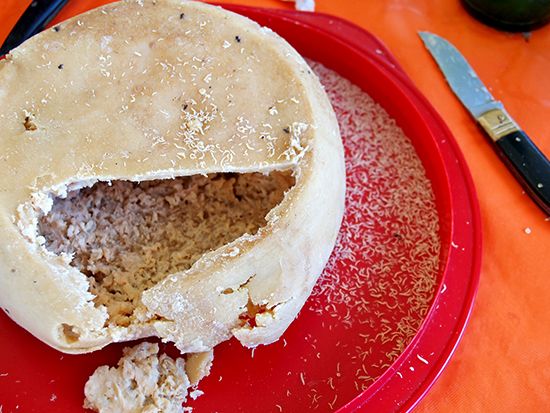casu marzu
Our editors will review what you’ve submitted and determine whether to revise the article.
- Also spelled:
- casu martzu
- Related Topics:
- maggot
- cheese
- cheese skipper fly
casu marzu, traditional Sardinian cheese made of sheep’s milk and containing live maggots, which are responsible for the cheese’s fermentation. Because of health concerns associated with the cheese, commercial sales of it are illegal in Italy. The cheese is also banned in several countries, including the United States. In 2009 the Guinness Book of World Records declared casu marzu “the most dangerous cheese” because “the maggots, once consumed, can survive stomach acid to pass through the intestine walls, causing vomiting, abdominal pain and bloody diarrhea.”
Casu marzu, which means “rotten cheese,” is an offshoot of pecorino sardo, a Sardinian cheese made from ewe’s milk. Its flavour and soft texture are similar to Gorgonzola. In spring a few cuts are made into the rind, and the larvae of a cheese fly known as Piophila casei are introduced to the cheese. The grubs are allowed to grow inside the cheese paste to encourage an advanced level of fermentation, one that most people would describe as decomposition. The developing grubs produce a spicy cream inside the cheese with a very soft melting texture, causing it to ooze beads of a liquid known as lagrima, which means “tears” in Italian.
Casu marzu is normally eaten with Sardinian bread (pane carasau) accompanied by Cannonau, a strong red wine. The translucent maggots, which should be alive when the cheese is eaten, are 1/3 inch (8 mm) long. If the maggots are not wriggling, the cheese has become toxic. Some people prefer to remove the larvae before eating; others devour them. Casu marzu’s flavour can best be described as pungent.

Banned since 1962 from sale in its traditional form even in its country of origin, casu marzu tends to be sold under the counter. There exists a substantial black market for the cheese, and shepherds produce small quantities of it for niche markets and also sell it to people who request it. Given the rising use of insects as a source of protein, however, local gastronomes are hopeful that the official restrictions will be lifted.


















